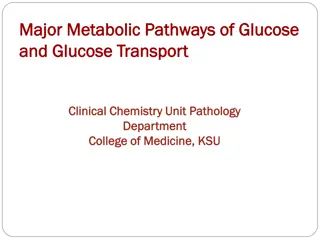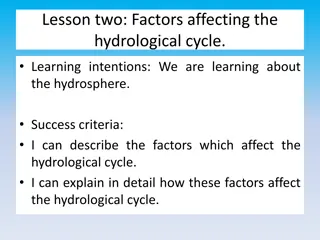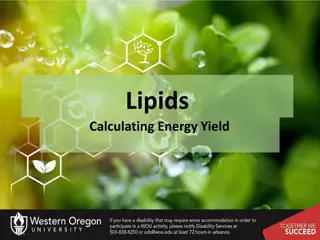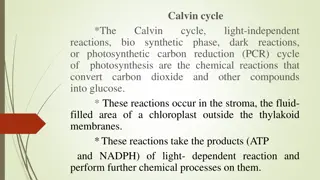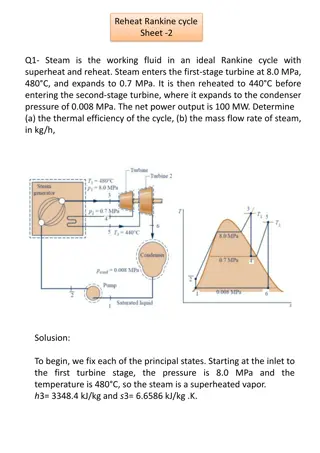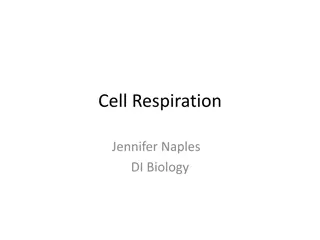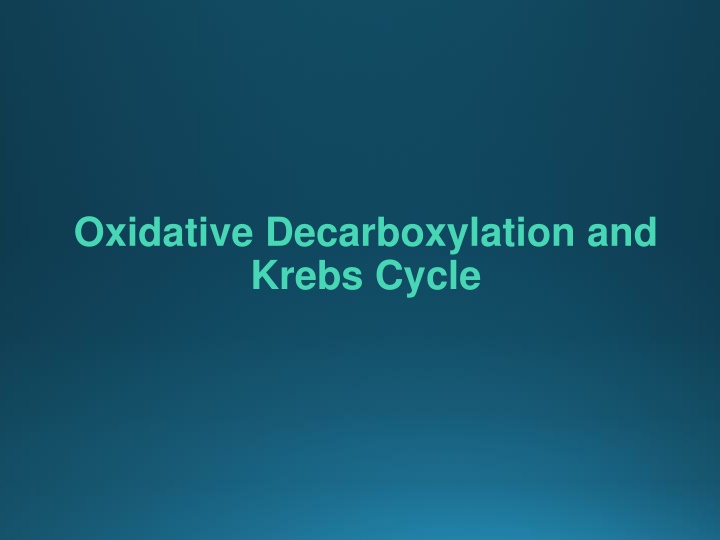
Oxidative Decarboxylation and Krebs Cycle in Metabolism
Explore the concepts of oxidative decarboxylation and the Krebs Cycle. Learn about the fates of pyruvate, regulatory mechanisms, and clinical implications. Dive into the importance, reactions, and energy yield of the Krebs Cycle. Understand the critical role of these processes in energy metabolism and ATP production.
Download Presentation

Please find below an Image/Link to download the presentation.
The content on the website is provided AS IS for your information and personal use only. It may not be sold, licensed, or shared on other websites without obtaining consent from the author. If you encounter any issues during the download, it is possible that the publisher has removed the file from their server.
You are allowed to download the files provided on this website for personal or commercial use, subject to the condition that they are used lawfully. All files are the property of their respective owners.
The content on the website is provided AS IS for your information and personal use only. It may not be sold, licensed, or shared on other websites without obtaining consent from the author.
E N D
Presentation Transcript
Oxidative Decarboxylation and Krebs Cycle
Objectives: Oxidative Decarboxylation By the end of this lecture, students are expected to: Recognize the various fates of pyruvate Define the conversion of pyruvate to acetyl CoA Discuss the major regulatory mechanisms for PDH complex Recognize the clinical consequence of abnormal oxidative decarboxylation reactions
Objectives: Krebs Cycle By the end of this lecture, students are expected to: Recognize the importance of Krebs cycle Identify various reactions of Krebs cycle Define the regulatory mechanisms of Krebs cycle Assess the energy yield of PDH reaction and Krebs cycle s reactions
Fates of Pyruvate ALT Alanine PLP Glutamate KG PLP = Pyridoxal Phosphate
Oxidative Decarboxylation of Pyruvate Allosteric Regulation
PDH Reaction: Clinical application 1. Deficiencies of thiamine or niacin can cause serious CNS problems. WHY? Brain cells are unable to produce sufficient ATP if the PDH complex is inactive. 1. Wernicke-Korsakoff (encephalopathy-psychosis syndrome) due to thiamine deficiency, may be seen especially with alcohol abuse. 2. PDH complex deficiency is the most common biochemical cause of congenital lactic acidosis.
Krebs Cycle The tricarboxylic acid cycle (Krebs) shown as a part of the essential pathways of energy metabolism. CoA = coenzyme A.
Tricarboxylic Acid Cycle: Krebs Cycle Final common pathway for oxidation Exclusively in mitochondria Major source for ATP Mainly catabolic with some anabolic features Synthetic reactions (anabolic features): Glucose from amino acids Nonessential amino acids Fatty acids Heme
Krebs Cycle Reactions (1) Formation of -ketoglutarate from acetyl coenzyme A (CoA) and oxaloacetate. NAD(H) = Nicotinamide adenine dinucleotide.
Krebs Cycle Reactions (2) Succinate Thiokinase Substrate-Level Phosphorylation Formation of malate from -ketoglutarate. NAD(H) = nicotinamide adenine dinucleotide GDP = guanosine diphosphate; P = phosphate FAD(H2) = flavin adenine dinucleotide.
Krebs Cycle Reactions (3) Formation (regeneration) of oxaloacetate from malate. NAD(H) = nicotinamide adenine dinucleotide
Krebs Cycle: Energy Yield Number of ATP molecules produced from the oxidation of one molecule of acetyl coenzyme A (CoA) using both substrate-level and oxidative phosphorylation.
Krebs Cycle: Energy Yield Number of ATP molecules produced from the oxidation of one molecule of acetyl coenzyme A (CoA) using both substrate-level and oxidative phosphorylation.
Net ATP Production by Complete Glucose Oxidation Aerobic glycolysis: 8 ATP Oxidative decarboxylation: 2 X 3 = 6 ATP Krebs cycle: 2 X 12 = 24 ATP Net: 38 ATP
Regulation of Oxidative Decarboxylation and Krebs Cycle PDH complex and the TCA cycle are both up-regulated in response to a decrease in the ratio of ATP:ADP NADH:NAD+ TCA cycle activators are: ADP Ca2+ TCA cycle inhibitors are: ATP NADH
Take Home Message Pyruvate is oxidatively decarboxylated by PDH to acetyl CoA inside the mitochondria Krebs cycle: Final common pathway for the oxidation of carbohydrates, fatty acids and amino acids Occurs in the mitochondria Aerobic Mainly catabolic, with some anabolic reactions The complete oxidation of one glucose molecule results in a net production of 38 ATP molecules
Reference Lippincott Illustrated Review of Biochemistry, 6th edition, 2014, Unit 2, Chapter 9, Pages 109-116.

